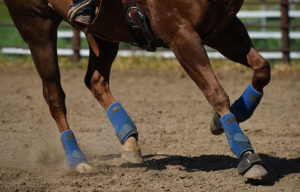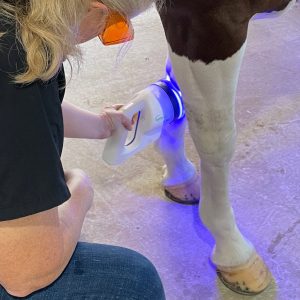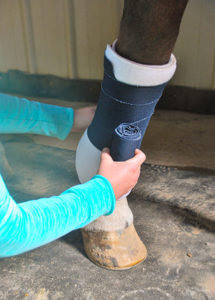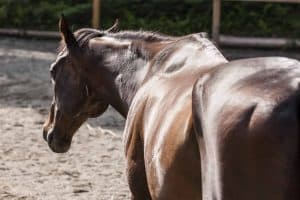How to Test Horse Hay Moisture Levels

Some horse owners have land that doubles as pasture for their horses and hay fields that they cut and bale one or more times each year. Many of these properties range from 3 or 4 to 20 acres and provide just enough hay for resident animals to eat year-round.
On our 10-acre horse property in Southwestern Idaho, we have a 6-acre grass pasture that we cut two to three times each summer. After 13 years of following this protocol, this year we ran into a problem—we realized (after stacking it in the hay barn) that some of our bales were damp. Storing damp hay for many months increases the risk for fire in your barn and mold growth, so we purchased a moisture meter to test the bales and determine which were safe to store and which should be fed immediately.
Why Should I Use a Moisture Meter for Hay?
“Landowners should invest in a moisture meter (which costs about $300) and learn how to use it,” says Glenn Shewmaker, PhD, a professor emeritus with University of Idaho Extension and a forage specialist based in Kimberly.
Second-cutting grass is immature and soft, so it’s naturally higher in moisture and, as the weather cools down in the fall, the moisture levels in the soil are higher, he adds. “Hay (that’s been cut and is drying on the ground) gains moisture during the night because of cooling temperatures on the ground surface. Moisture rises from soil (and condenses on the cold hay), keeping the bottom of the windrow (a long line of cut hay) moist.” This makes it challenging to properly dry hay in the autumn months.

Moisture meters are geared toward alfalfa, which is stemmier than grass, but they still work well for grass hay, says Shewmaker. Readings will help you understand the amount of moisture in your windrow or your baled hay and if it is safe to store.
Preventing Spontaneous Combustion of Hay in in Horse Barns or Storage Sheds
Hay storage areas are one of the most common places for fires to start. One probable cause is wet hay that’s either been rained on or was baled when still green and not completely dry.
Excessive moisture leading to spontaneous combustion is the most common culprit when it comes to fires in hay bales or haystacks.
High moisture levels in the hay allow fungi and microbes to break down the plant material, and the byproduct of that decomposition is heat. When the internal temperature rises in a stack, an exothermic chemical reaction can cause the temperature to rise to the point of ignition, leading to combustion.
“Anytime the temperature is taken (of a hay bale) and it’s 150 degrees or over, you have a real problem,” says Hines. If you smell smoke or musty conditions, moving the hay could become very dangerous. “If someone suspects they have a haystack where it might be wet and getting hot and they start pulling it apart, it could spontaneously combust. They already have heat and fuel and now, when pulling it apart, they are adding oxygen.”
Hines stresses the need to contact your local fire department immediately if you find the temperature of your hay is 150 degrees or more. It doesn’t take much for a barn fire to spread, so prevention is the best way to protect your hay and animals.
How to Use a Moisture Meter to Test Hay
When getting ready to bale your hay, test its moisture levels while drying in windrows using this technique: “Take a sample of the (drying) hay and stuff it into a 2-foot length of 4-inch diameter PVC pipe,” says Shewmaker. “Pack it (in tightly) by pressing a 3-inch diameter PVC pipe with end caps into the tube with the hay.” This will simulate the density of baled hay for which the moisture probe is calibrated. Test the compacted hay in the tube by inserting the hay probe into the center of the sample.
“The moisture meter reading on the hay probe should be below 18% for two-string bales,” he adds. Repeat the process 12 to 20 times in different parts of the of the field to determine the average moisture levels of your hay. If you notice several readings of at least 20%, leave the hay out to dry longer.
“It doesn’t matter if it’s alfalfa or grass, follow directions that come with hay tester,” says Steven Hines, MS, extension specialist at the University of Idaho, in Moscow. The moisture meter needs to be in tight contact with the plant material to get an accurate reading, so be sure you’ve compacted the hay sufficiently.
Best Management Practices for Drying Hay
It is your responsibility as a landowner to ensure your hay is dried appropriately before baling and storing it. To help you end up with good, dry hay, Hines suggests these basic management rules:
- Never cut your grass and drop hay onto wet ground; if soil is wet, the dry plant material will wick moisture from it.
- To help your hay dry, ask the swather operator to lift the swather deck up a few inches (not cutting the grass as short and leaving several inches) so the plant stems will prop up the windrow a bit and help it dry. What’s left on the plant will go into your next cutting.
- Try not to cut hay when bad weather (i.e., rain) is imminent.
- Bale grass during the day after any dew has burned off.
- Pay attention to microclimates within your field. If you have a field on a slope, heavy dew will collect toward the bottom; be sure to check moisture levels where dew settles. The same is true for hay cut near an irrigation ditch, pond, or other body of water.
- Check that the hay is distributed evenly after it has been cut and formed into windrows. If there are big, deep areas, such as where the swather stopped, spread them out by hand. Ask the swather operator to lay the windrows as wide as possible.
- Test hay in windrows before baling using the moisture meter method described above. Hines recommends a moisture level below 20% for small bales, but he says 15% is safest.
- Pay attention to the weight of your bales when stacking them. A heavy bale can indicate its moisture level might be too high.
Take-Home Message
When we found the damp bales this fall, using a moisture meter helped us determine that 10% of that hay cutting was baled too damp. We stored the 90% that was under 15% moisture, then fed the rest immediately, to avoid fire—which could have taken our entire hay store, the storage building, and anything else in it—and mold growth.
Growing and baling your hay can be a challenging task, but ensuring your hay is safe to bale is crucial in preventing barn fires and moldy hay. A moisture meter can help you make an informed decision when determining when to bale your hay.
When purchasing a moisture meter, be sure to look at reviews online and recognize that “anything of quality is going to cost some money,” says Hines.
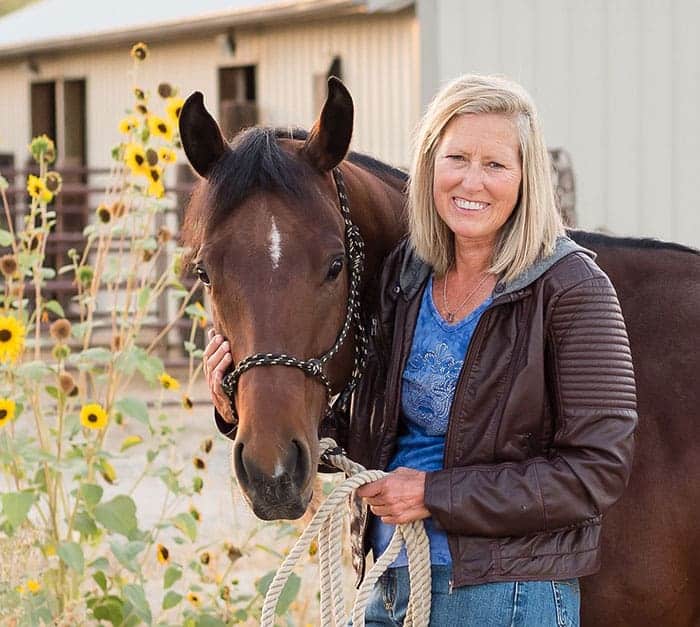
Written by:
Alayne Blickle
Related Articles
Stay on top of the most recent Horse Health news with





